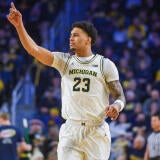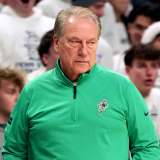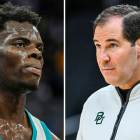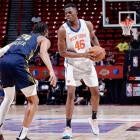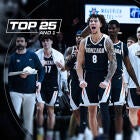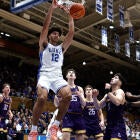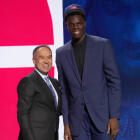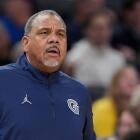2023 NCAA Tournament: Which First Four team has the best chance for a deep March Madness run?
Since the First Four started in 2011, 10 First Four teams have won multiple games

Let's be honest here, the First Four is often overlooked. Brackets aren't due until the first round starts on Thursday. And it's certainly understandable if you miss the action Tuesday and Wednesday because there's a ton of college hoops coming from Thursday through Sunday.
But you're also missing vital information you can use to fill out your bracket. This will mark the 12th NCAA Tournament that features a "First Four." Of the previous 11, 10 featured a team advancing to at least the Round of 32.
| Year | Team | Result |
|---|---|---|
| 2011 | (11) VCU | Final Four |
| 2012 | (12) USF | Round of 32 |
| 2013 | (13) La Salle | Sweet 16 |
| 2014 | (11) Tennessee | Sweet 16 |
| 2015 | (11) Dayton | Round of 32 |
| 2016 | (11) Wichita St | Round of 32 |
| 2017 | (11) USC | Round of 32 |
| 2018 | (11) Syracuse | Sweet 16 |
| 2021 | (11) UCLA | Final Four |
| 2022 | (11) Notre Dame | Round of 32 |
With all due respect to the No. 16 seed play-in teams, the four No. 11 seed play-in teams hoping to replicate that feat are Arizona State, Nevada, Mississippi State and Pittsburgh. All have major pluses and minuses. That's why they were on the bubble in the first place. Mix impressive wins with confounding losses, and you get a résumé that was good enough to get you in but not good enough to even guarantee a spot in the Round of 64.
As I examined last year, there's no true pattern to identifying which teams will take their First Four opportunity and run with it. Late-season momentum doesn't necessarily carry over, but that doesn't mean it can't help. A propensity for beating top teams is good experience but doesn't guarantee you much once the Big Dance begins. Having said that, there are ways to pick out which teams could join 2011 VCU and 2021 UCLA in First Four-to-Final Four lore -- or, at least which ones could help you nail a key Round of 64 upset.
1. (11) Mississippi State
The phrase "there are no pictures in the box score" fits Mississippi State perfectly. The Bulldogs are among the worst shooting teams in the country and worst overall offensive teams in the tournament. They play slowly, shoot poorly from pretty much everywhere and turn the ball over.
They are as tough as they come, however. In his first year in Starkville, coach Chris Jans has assembled a bunch that looks similar to many of his New Mexico State teams. The Bulldogs hit the boards hard -- they rank 17th in offensive rebounding percentage -- and defend well. Kenpom has the Bulldogs sixth nationally in defensive efficiency and inside the top 25 in effective field goal percentage allowed and turnover rate forced.
Offensively, it all revolves around Tolu Smith, who comes into the NCAA Tournament riding three straight double-doubles. His 380 points at the rim ranks fifth in all of Division I, alongside similarly dominant but more nationally known big men such as Trayce Jackson-Davis, Zach Edey and Azuolas Tubelis.
Now, Smith gets a Pittsburgh defense that has generally been solid on the inside but just gave up 44 points at the rim in a 96-69 loss to Duke in the ACC Tournament. The Panthers really struggle rebounding the ball -- they're 12th out of 15 teams in defensive rebounding rate in ACC play -- and Smith should be ready to feast.
Mississippi State beat Marquette on a neutral floor, and then between the last week of January and the first week of March, beat fellow NCAA Tournament teams TCU, Missouri, Arkansas and Texas A&M. Their losses over that span? By three at Alabama, by three against Kentucky, by two in overtime at Missouri and by five at Vanderbilt. One win from that bunch and this could be an 8 or 9 seed. Plus, Jans knows how to pull off an upset: His New Mexico State team beat No. 4 seed UConn in the Round of 64 last year.
2. (11) Nevada
Nevada's bid to the NCAA Tournament looked to be relatively safe until three straight losses closed the season. The Wolf Pack had to deal with a nervous Selection Sunday, but the work Steve Alford's team did in the middle of the season paid off. Now, will a place in the NCAA Tournament rejuvenate what at one time looked to be one of the country's best mid-majors?
It has to start with Kenan Blackshear, because his team goes as he goes. He averaged 15 points on 51.2% shooting in wins and 13.3 points on 32.6% shooting in losses. A 6-foot-6, 215-pound point guard, Blackshear must be aggressive getting downhill. In his best outing this season -- a 28-point outburst against Utah State -- all 15 of his shots from the field were 2-pointers, and he also went to the free throw line 11 times, making 10.
When Blackshear gets going, this is a tough offense to stop. Will Baker is a 7-footer with 3-point range (35.6%) and Jarod Lucas can also nail them from deep (37.2%). Nevada's biggest drawback is its depth -- the Wolf Pack rank 337th in bench minutes -- but the starting group is good enough to -- and often has to -- carry the team.
If the Wolf Pack can get past Arizona State, they could be a good matchup for TCU in the Round of 64. TCU loves to force turnovers and get out in transition, but Nevada had the Mountain West's lowest turnover percentage.
If there are two areas to look for in any successful NCAA Tournament team, it's free throws and good, experienced guards. Nevada is the best free throw-shooting team in the Tournament (79.1%), and in Blackshear, there's an experienced guard who can be really, really good. That's a good combination.
3. (11) Arizona State
In a similar mold to Mississippi State, Arizona State also doesn't shoot it particularly well but plays decent defense. The Sun Devils are better offensively and not as good defensively as the Bulldogs, but the relative strengths and weaknesses match up.
That's where the similarities stop. Arizona State plays at a much faster pace and shoots 3-pointers at a much higher rate (even though the Sun Devils aren't very good at them). Bobby Hurley's starting five are all transfers, two of which are brothers (Desmond and Devan Cambridge) and three are capable ball handlers. They're in the NCAA Tournament for one reason: Desmond Cambridge's halfcourt heave to win at Arizona. Without that, there's probably not quite enough to outweigh some pretty bad losses, including at 37-point shellacking at San Francisco.
But that's all in the past, and the Sun Devils have some ingredients here. Desmond Cambridge can really score and Warren Washington is a legitimate rim protector who will be facing his former team in Nevada. But the issue might just come down to making enough shots. Nevada ranks 82nd nationally in true shooting percentage. Arizona State is 324th.
4. (11) Pittsburgh
The Panthers spent much of 2023 battling for an ACC regular-season title. Then they lost three of their last five regular-season games, fell to fifth in the standings, nearly blew a 15-point lead to Georgia Tech in their first ACC Tournament game and lost to Duke by 27 in their second.
I don't mean to disparage Jeff Capel nor his team, both of whom have been among college basketball's best stories and biggest overachievers. It's just that the recent results don't inspire confidence for a big run. Since the Feb. 18 loss at Virginia Tech that began this late-season stumble, Pitt has the worst defense in the ACC and is surrendering over 40% shooting from three. Could that regress to the mean? Sure. Is cold-shooting Mississippi State going to take advantage of that leaky perimeter defense? Probably not. But when talking about a deep March run, it's hard to envision Pitt being the ones here.
That doesn't, however, mean it's impossible. Capel has one of the nation's oldest groups, and four starters have prior NCAA Tournament experience. Nelly Cummings even had 20 points in last year's Tournament when Colgate put a scare into Wisconsin. But the late-season struggles are hard to overlook and will be equally hard for Pitt to overcome.




